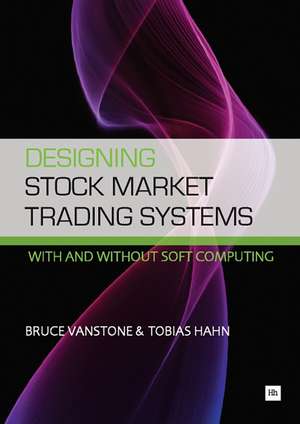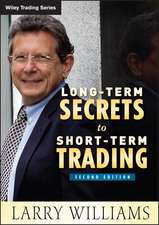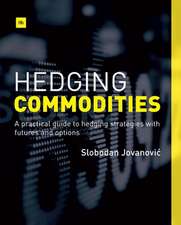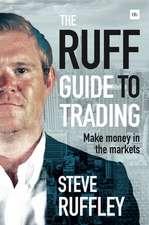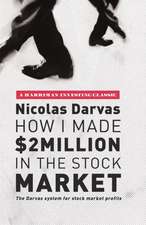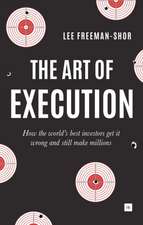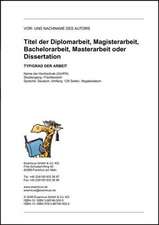Designing Stock Market Trading Systems
Autor Bruce Vanstone, Tobias Hahnen Limba Engleză Paperback – 30 sep 2010
Preț: 373.49 lei
Preț vechi: 434.37 lei
-14% Nou
Puncte Express: 560
Preț estimativ în valută:
71.49€ • 77.68$ • 60.09£
71.49€ • 77.68$ • 60.09£
Carte disponibilă
Livrare economică 01-15 aprilie
Preluare comenzi: 021 569.72.76
Specificații
ISBN-13: 9781906659585
ISBN-10: 1906659583
Pagini: 262
Dimensiuni: 178 x 254 x 15 mm
Greutate: 0.48 kg
Editura: HARRIMAN HOUSE LTD
ISBN-10: 1906659583
Pagini: 262
Dimensiuni: 178 x 254 x 15 mm
Greutate: 0.48 kg
Editura: HARRIMAN HOUSE LTD
Cuprins
Preface Acknowledgements Introduction 1. Designing Stock Market Trading Systems 1.1 Introduction 1.2 Motivation 1.3 Scope and Data 1.4 The Efficient Market Hypothesis 1.5 The Illusion of Knowledge 1.6 Investing versus Trading 1.6.1 Investing 1.6.2 Trading 1.7 Building a Mechanical Stock Market Trading System 1.8 The Place of Soft Computing 1.9 How to Use this Book 2. Introduction to Trading 2.1 Introduction 2.2 Different Approaches to Trading 2.2.1 Direction of trading 2.2.2 Time frame of trading 2.2.3 Type of behaviour exploited 2.2.3.1 Trend-based trading 2.2.3.2 Breakout trading 2.2.3.3 Momentum trading 2.2.3.4 Mean reversion trading 2.2.3.5 High-frequency trading 2.3 Conclusion 2.4 The Next Step 3. Fundamental Variables 3.1 Introduction 3.1.1 Benjamin Graham and value investing 3.2 Informational Advantage and Market Efficiency 3.3 A Note on Adjustments 3.4 Core Strategies 3.4.1 Intrinsic value estimates 3.4.2 Fundamental filters 3.4.3 Ranking filters 3.5 The elements of a fundamentals-based filter 3.5.1 Wealth of a firm and its shareholders 3.5.1.1 Book value 3.5.1.2 Current assets vs. current liabilities 3.5.1.3 Leverage metrics 3.5.2 Earnings capacity 3.5.3 Ability to generate cash 3.6 Fundamental Ratios and Industry Comparisons 3.7 A Final Note on Cross-country Investing Research 3.8 The Next Step 3.9 Case Study: Analysing a Variable 3.9.1 Introduction 3.9.2 Example - P/E ratio 3.9.3 Wealth-Lab 3.9.4 SPSS 3.9.5 Outliers 4. Technical Variables 4.1 Introduction 4.1.1 Charting 4.1.2 Technical indicators 4.1.3 Other approaches 4.2 Charting and Pattern Analysis 4.3 Technical Indicators 4.3.1 Intermarket analysis 4.3.2 Moving averages 4.3.3 Volume 4.3.4 Momentum indicators 4.3.4.1 Moving Average Convergence/Divergence (MACD) 4.3.4.2 Relative Strength Indicator (RSI) 4.4 Alternative Approaches 4.5 On Use and Misuse of Technical Analysis 4.6 Case Study: Does Technical Analysis Have Any Credibility? 5. Soft Computing 5.1 Introduction 5.1.1 Types of soft computing 5.1.2 Expert systems 5.1.3 Case-based reasoning 5.1.4 Genetic algorithms 5.1.5 Swarm intelligence 5.1.6 Artificial neural networks 5.2 Review of Research 5.2.1 Soft computing classification 5.2.2 Research into time series prediction 5.2.3 Research into pattern recognition and classification 5.2.4 Research into optimisation 5.2.5 Research into ensemble approaches 5.3 Conclusion 5.4 The Next Step 6. Creating Artificial Neural Networks 6.1 Introduction 6.2 Expressing Your Problem 6.3 Partitioning Data 6.4 Finding Variables of Influence 6.5 ANN Architecture Choices 6.6 ANN Training 6.6.1 Momentum 6.6.2 Training rate 6.7 ANN In-sample Testing 6.8 Conclusion 6.9 The Next Step 7. Trading Systems and Distributions 7.1 Introduction 7.2 Studying a Group of Trades 7.2.1 Average profitability metrics 7.2.1.1 The students t-test 7.2.1.2 The runs test 7.2.2 Winning metrics 7.2.3 Losing metrics 7.2.4 Summary metrics 7.2.5 Distributions 7.2.5.1 Short-term distribution 7.2.5.2 Medium-term distribution 7.2.5.3 Long-term distribution 7.2.6 Comparing two sets of raw trades 7.3 Conclusions 7.4 The Next Step 8. Position Sizing 8.1 Introduction 8.1.1 Fixed position sizing 8.1.2 Kelly method 8.1.3 Optimal-f 8.1.4 Percentage of equity 8.1.5 Maximum risk percentage 8.1.6 Martingale 8.1.7 Anti-martingale 8.2 Pyramiding 8.3 Conclusions 8.4 The Next Step 9. Risk 9.1 Introduction 9.2 Trade Risk 9.2.1 Stop-loss orders 9.2.2 Using maximum adverse excursion (MAE) to select the stop-loss threshold 9.3 Risk of Ruin 9.4 Portfolio Risk 9.5 Additional Portfolio Metrics 9.6 Monte Carlo Analysis 9.7 Case Study: Are Stops Useful in Trend Trading System? 10. Case Studies 10.1 Introduction 10.2 A Note about Data 10.3 A Note about the Case Studies 10.4 Building a Technical Trading System with Neural Networks 10.4.1 Splitting data 10.4.2 Benchmark initial rules 10.4.3 Identify specific problems 10.4.4 Identify inputs and outputs for the ANN 10.4.5 Train the networks 10.4.6 Derive money management and risk settings 10.4.7 In-sample benchmarking 10.4.8 Out-of-sample benchmarking 10.4.9 Decide on final product 10.5 Building a fundamental trading system with neural networks 10.5.1 Splitting data 10.5.2 Benchmark initial rules 10.5.3 Identify specific problems 10.5.4 Identify inputs and outputs for ANN 10.5.5 Train the networks 10.5.6 Derive money management and risk settings 10.5.7 In-sample benchmarking 10.5.8 Out-of-sample benchmarking 10.5.9 Decide on final product Final Thoughts Appendices Script Segments Bibliography Index
Descriere
Most people know there is potential to make big money in the stock market, but they don't know how to get started. This work guides readers step by step through the authors' methods for building rule-based stock market trading systems.
Notă biografică
Bruce Vanstone andTobias Hahn
